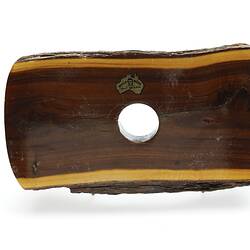Summary
Note: This object includes a derogatory slur and reference to First Nations people. Such words and sentiments are not condoned by Museums Victoria which considers them to be racist. Historical distance and context do not excuse or erase this fact.
Oblong shaped piece of mulga wood with the centre cut out for an inkwell.The Mulga wood 'Abo' brand was patented by Albert J. Wiley of Adelaide in 1932. A.J. Wiley had owned a woodturning business in Adelaide at least since 1902. By the 1930s Wiley had become a specialist in mulga wood ornaments. Wiley inspired Fred Eaton, camp missionary at Nepabunna, to install lathes at the mission in order to teach the Aboriginal people under his care woodturning in 1938.
Physical Description
Oblong shaped piece of mulga wood with the bark left on the top side side. The centre has been carved out and there is a plastic insert for the inkwell. On one side there are two metal hooks upon which a pen would rest. On the reverse is stamped in gold the maker's mark of a map of Australia, missing Tasmania and the face of a bearded Aboriginal man.
Significance
The historical significance of this ink well is in its brand name which uses the racial slur 'Abo', combining it with an Aboriginal man's head and outline map of Australia as a trademark. Mulga wood, an Australian acacia, was used by Aboriginal people to make boomerangs, spear points and shields. In the early twentieth century the wood became a popular timber for ornaments and souvenirs, such as this cribbage board. The way this particular piece was branded shows an awareness of a new Australian identity after Federation while exploiting Aboriginal imagery and and legitimising a common racial slur.
The use of images of Aboriginal people and the word 'Abo' has reappeared in a contemporary context with Tourism NT, a Northern Territory government agency who had paid for a sponsored Google link to this slur on the internet until it was removed on May 12, 2010. This object forms part of a small collection of objects which demonstrate the various ways Indigenous imagery, designs and materials have been referenced, appropriated and even exploited to produce popular consumer products which at times are branded in inappropriate and even offensive ways.
More Information
-
Collecting Areas
-
Acquisition Information
Purchase
-
Maker
Mr Albert J Wiley, Adelaide, Greater Adelaide, South Australia, Australia, 1930s
-
Inscriptions
Reverse: maker's mark: Mulga wood Abo brand
-
Classification
-
Category
-
Discipline
-
Type of item
-
Overall Dimensions
196 mm (Width), 117 mm (Depth), 50 mm (Height)
-
References
[Link 1] [Link 2] South Australia, Report of the Chief Protector of Aborigines for the year ended 30th June, 1938, p.2 [Link 3] [Link 4]
-
Keywords
Aboriginal Depictions, Office Equipment, Racism, Woodturning Industry, Cultural Stereotypes








